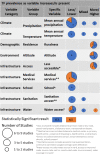Community-level trachoma ecological associations and the use of geospatial analysis methods: A systematic review
- PMID: 35395003
- PMCID: PMC9020723
- DOI: 10.1371/journal.pntd.0010272
Community-level trachoma ecological associations and the use of geospatial analysis methods: A systematic review
Abstract
Background: Trachoma is targeted for global elimination as a public health problem by 2030. Understanding individual, household, or community-associated factors that may lead to continued transmission or risk of recrudescence in areas where elimination has previously been achieved, is essential in reaching and maintaining trachoma elimination. We aimed to identify climatic, demographic, environmental, infrastructural, and socioeconomic factors associated in the literature with trachoma at community-level and assess the strength of their association with trachoma. Because of the potential power of geospatial analysis to delineate the variables most strongly associated with differences in trachoma prevalence, we then looked in detail at geospatial analysis methods used in previous trachoma studies.
Methods: We conducted a systematic literature review using five databases: Medline, Embase, Global Health, Dissertations & Theses Global, and Web of Science, including publications from January 1950 to January 2021. The review protocol was prospectively registered with PROSPERO (CRD42020191718).
Results: Of 35 eligible studies, 29 included 59 different trachoma-associated factors, with eight studies also including spatial analysis methods. Six studies included spatial analysis methods only. Higher trachomatous inflammation-follicular (TF) prevalence was associated with areas that: had lower mean annual precipitation, lower mean annual temperatures, and lower altitudes; were rural, were less accessible, had fewer medical services, had fewer schools; and had lower access to water and sanitation. Higher trachomatous trichiasis (TT) prevalence was associated with higher aridity index and increased distance to stable nightlights. Of the 14 studies that included spatial methods, 11 used exploratory spatial data analysis methods, three used interpolation methods, and seven used spatial modelling methods.
Conclusion: Researchers and decision-makers should consider the inclusion and potential influence of trachoma-associated factors as part of both research activities and programmatic priorities. The use of geospatial methods in trachoma studies remains limited but offers the potential to define disease hotspots and areas of potential recrudescence to inform local, national, and global programmatic needs.
Conflict of interest statement
I have read the journal’s policy and the authors of this manuscript have the following competing interests: All authors have declared that no competing interests exist.
Figures
References
-
- Francis V, Turner V. Achieving Community Support for Trachoma Control: A guide for district health work. Geneva, Switzerland: WHO, 1995. WHO/PBL/93.36.
-
- World Health Organization. Report of the 3rd Global Scientific Meeting on Trachoma. Geneva, Switzerland: 2010.
Publication types
MeSH terms
Grants and funding
LinkOut - more resources
Full Text Sources
Medical
Miscellaneous




